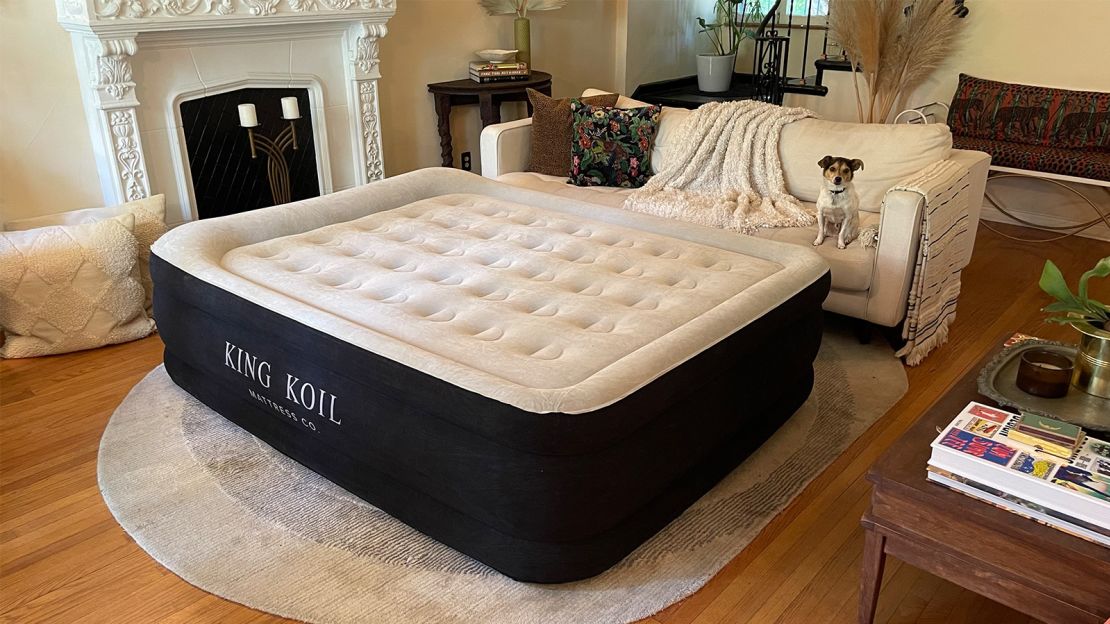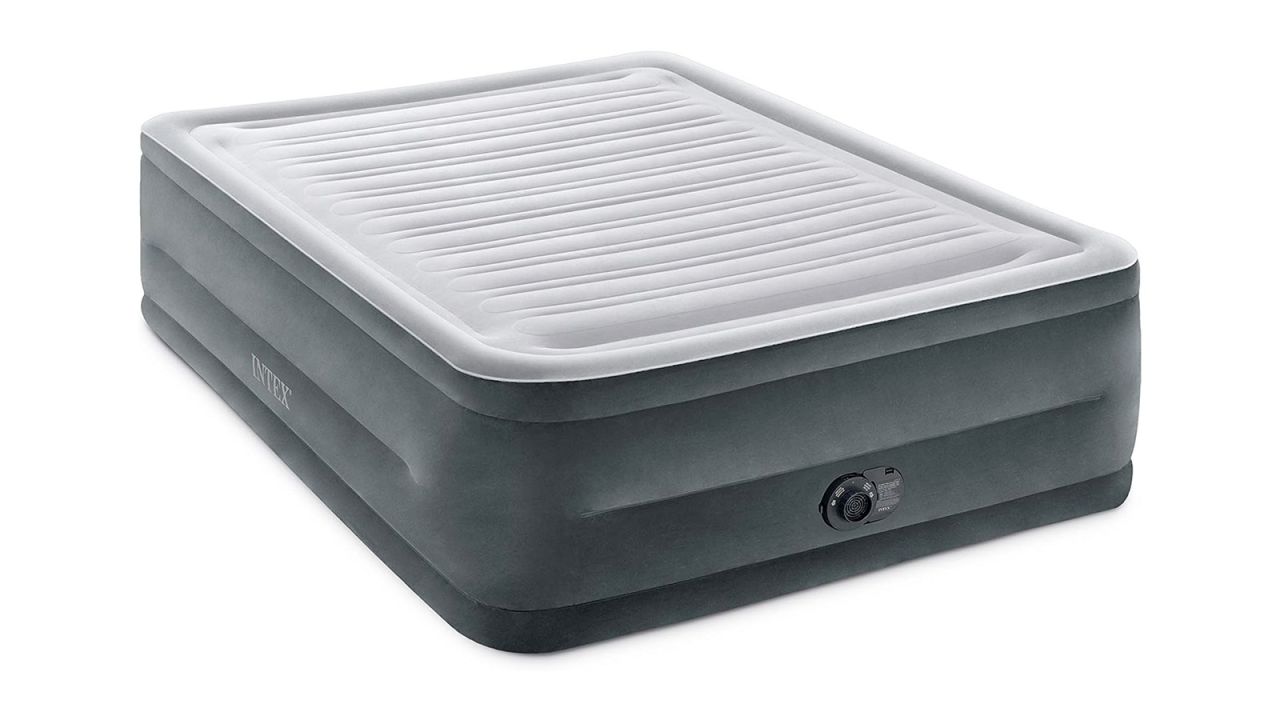You may not use an air mattress often but when the time comes, you’ll want one that’s reliable, comfortable and easy to inflate and store. You don’t want to struggle to set it up, you need it to be supportive enough to provide a good night’s rest and the last thing you or your guests want is to wake up in the middle of the night, floundering in a half-deflated blob of vinyl.
To wade through the wide variety of what’s available, we set out to find the best air mattress by putting seven top models to the test. We judged them on their comfort while sleeping (of course) and assessed their overall usability for setting it up, inflating and deflating it, and storing it.
If you haven’t shopped for an air mattress in a while, you’ll be surprised to find how comfortable and convenient they are nowadays — some of them could honestly hold their own against even the best mattresses we’ve tested. But even among this impressive group, we found an outstanding choice that should make you and your guests happy.
In addition to providing the most comfortable night’s sleep during testing, the King Koil Luxury Air Mattress uses a built-in pump for quick and convenient inflation and has a raised pillow that helps mimic the feel of a real bed. We tested the 20-inch-high queen size.
The best air mattress: King Koil Luxury Air Mattress

While many of the air mattresses I tested were similar in design, pump operation and dimensions, the King Koil Luxury Air Mattress was a clear winner in overall comfort. Not only does it feature a soft, velvety flocking covering the top, but it’s also designed with a raised pillow area on one end. This area provides just enough head and neck support to mimic the effect of a headboard, making it feel much more like a real bed to me than any other option.
The King Koil Luxury Air Mattress also provided plenty of full-body support. The “coil-beam construction” does sound gimmicky but these internal, air-filled coils worked as advertised. They provided the ideal amount of support, mimicking a real mattress more convincingly than any other air mattress I tested. Since the coils are spaced throughout the mattress, edge to edge, I never felt like the sides would give way and cause me to roll out, which is sometimes the case in less supportive mattresses. I did experience a small amount of deflation over my 48 hours of testing but it was minimal enough to chalk up to standard stretching of the new material. In addition to the two nights of sleeping, I found myself lying on it throughout the day, just to experience its comfort and support.
At 20 inches high, the King Koil Luxury Air Mattress is convenient to climb into at night, and more importantly, comfortable to roll out of in the morning. Air mattresses lower to the ground are more difficult to get into and out of, and the process involved more grunting and bending than I was prepared to do first thing in the morning. This wasn’t the case with the King Koil.

The pump was easy to use and quick to fill, fully inflating the mattress in just 1 minute and 50 seconds. You need only twist the valve you want to use — either inflate or deflate — press the power switch and you’re set. The power cord conveniently stores inside a little storage cubby with a latching door, keeping everything nice and tidy when it’s time to store the mattress away.
As for storage, despite its luxurious height and internal structure the King Koil packs up very tidily into a storage sack small enough to tuck into the back of a closet. Some competitors were stiff and difficult to fold up easily, and others were too large even folded away into their stuff sacks to store away easily.

The materials used in the mattress and pump appear to be of high quality, and I never felt like any elements or components were flimsy, loose, or weak. Deflation was also easy, taking just 1 minute and 50 seconds to go from full to empty. It took me less than a minute to fold it up and slide it back into the included storage bag too, thanks to the illustrated instructions in the manual.

The King Koil Luxury Air Mattress is not cheap relative to the competition but the overall comfort, build quality and speedy inflation make it worth the money.
How we tested
To help better understand the benefits and drawbacks of the air mattresses we tested, we ran each mattress through a comprehensive battery of real-world tests, from setup to packing and unpacking and, of course, sleeping, evaluating them across a range of criteria but focusing on comfort and convenience.
Setup
- Ease of use: Since air mattresses are frequently set up in areas not typically used for a bed, and sometimes last-minute, they must be easy to use. Nobody wants to fumble around with a confusing air pump or dig for an instruction manual when you just want to sleep. I paid close attention to how simple — or complicated — each mattress was to operate, from unboxing, to setup, inflation, deflation, and finally storage.
- Included pump: I noted any specific issues with the pump operation controls and the helpfulness of each mattress’s instruction manual.
Performance
- Comfort: To accurately judge each mattress on the most important measure of performance (its comfort and support while sleeping), I slept on each model for two nights, noting both how comfortable their soft topper was, as well as overall stability.
- Deflation during sleep: I also paid close attention to any deflation issues overnight. Although minor deflation is expected with new air mattresses — the vinyl material stretches — I did my best to notice any significant deflation that could indicate actual issues down the road.
- Inflation experience: I compared each mattress pump as well, evaluating them on how easy they were to set up, notable noise differences, and how long it took them to fully inflate the mattress.
Storage
- Take down: After testing each mattress, I deflated and rolled (or folded) each mattress and stored it and any pumps in their included storage bag. I noted how easy this process was from start to finish, paying attention to how well the pump deflated the mattress, if any included instructions made it easier to fold up the mattress correctly, and how easy it was to fit into the storage bag.
Build
- Quality: During testing, I kept track of any issues concerning build quality. Flimsy switches or valve openings, and any noticeable seam or molding issues with the vinyl or soft topper helped me evaluate one mattress versus another.
- Size: In addition to these testing categories, I also compared specific metrics like overall weight, the dimensions of each mattress when folded up, and warranty lengths.
How to take care of an air mattress
Even high-quality air mattresses won’t last forever, but there are things you can do to extend their lifespan. Avoid punctures by keeping your pets off the bed — even small dogs can have sharp toenails that can puncture or scratch through an air mattress — and avoid unnecessary pressure by preventing rambunctious kids from jumping or walking on it. This extra pressure can place more stress on the seams, causing splits and cracks over time. Insta-bed also recommends not placing the mattress against a wall to avoid hidden carpet tacks.
Take the time to vacuum your mattress after every use. Accumulated crumbs and other small debris can also pose a potential puncture threat, especially when folding it up and squeezing it down during deflation.
The most important thing to remember is that cold temperatures can make vinyl stiffen, so if it’s stored in a cool area, like a basement or attic, allow your air mattress to come to room temperature before inflating. If not, the vinyl may lack the flexibility to expand safely, which can cause cracks or splits in the material. The Insta-bed manual also recommends this warming-up period after your bed is delivered to your doorstep since it could have been sitting outside longer than you think.
If your bed does get damaged, it’s not a lost cause. Every mattress I tested included a patch kit for leaks, which, if applied properly, can easily fix the problem. Should your built-in pump go haywire, some mattresses allow you to fill them manually with a separate pump.
How to take an air mattress camping
Taking an air mattress camping isn’t only feasible, it’s an amazing way to stay comfortable while roughing it. If you’d prefer to sleep off the ground and not worry about roots and uneven ground impairing your sleep, then air mattresses could be a great choice. However, you’ll need to be aware of their limitations and the effects they may have on your trip.
First, since air mattresses are extremely vulnerable to punctures, you don’t want them to lay directly on the ground. You’ll want to ensure they keep clear of stray campfire embers that could melt the vinyl, too. While patching holes is a solution, it’s not an ideal project to perform in the wilderness. Keep in mind you can just as easily puncture your mattress when it’s folded up, so don’t pack it with sharp objects. Air mattresses are also relatively heavy, and depending on how long you plan on carrying them to your site, this weight can be more trouble than it’s worth.
Perhaps most importantly, you’ll need to ensure you have a reliable way to inflate your air mattress. If you want to take advantage of the convenience and quick performance of built-in pumps, you’ll need a power source, like a car cigarette lighter, or a campsite power hookup. If you’ll be away from electricity, you’ll need a mattress with a battery-powered pump, like the Intex Dura-Beam Standard Single-High Air Mattress, or a mattress with a manual foot pump. If these limitations sound like they won’t work with you and your trip, you’ll probably be better off with a camping pad.























